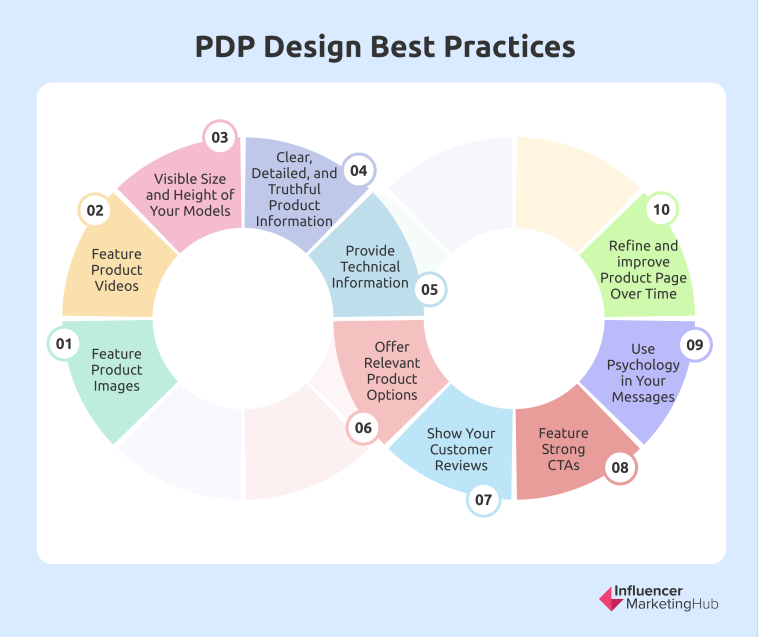Product Detail Pages (PDPs) are the bread and butter of any eCommerce website. They are the pages where customers make their final purchasing decisions, and as such, are the most important pages on your site. PDPs are also a critical part of your brand identity. They communicate your brand's personality, values, and style, and can help differentiate you from your competitors.
Creating effective PDPs requires a deep understanding of your customers' psychology, as well as expert knowledge of design principles and best practices. For example, high-quality product images are a must-have for PDPs, as they help customers visualize the product and make informed buying decisions.
But it's not just about images. Your PDPs should also provide clear, detailed, and accurate information about your products, including shipping and delivery information, pricing, and return policies. And don't forget about product recommendations and upsells, which can increase the value of each sale and encourage repeat business.
Of course, effective PDP design is not just about what you include on the page, but also how you present that information. From font choices to layout, every design element should be carefully considered to maximize the impact of your PDPs. For example, including size and height information for models can help customers better understand how a product will fit, reducing the likelihood of returns.
Mastering PDP Optimization in 2024, a Comprehensive Guide for eCommerce Success:
- Feature Product Images
- Feature Product Videos
- Visible Size and Height of Your Models
- Clear, Detailed, and Truthful Product Information
- Provide Technical Information
- Offer Relevant Product Options
- Show Your Customer Reviews
- Feature Strong CTAs
- Use Psychology in Your Messages
- Refine and improve Product Page Over Time
Best Practices for PDP Design
When it comes to PDP design, there is no one-size-fits-all solution. Every brand, every product, and every customer is unique, and your PDPs should reflect that. That's why it's critical to continuously analyze and optimize your PDPs based on customer feedback, data, and emerging design trends.
Feature Product Images
Product images are one of the most important elements of any eCommerce website, and for good reason. In fact, studies have shown that 67% of consumers consider high-quality images to be very important when making a purchase decision.
This means that it’s absolutely essential to feature high-quality product images on your PDPs in order to drive conversions and increase sales. But what exactly does that mean?
First and foremost, high-quality product images should be big, clear, and of the highest resolution possible. This will allow your customers to see your products in great detail and from all angles, just as they would in a physical store.

Source: amazon.com
It’s important to optimize your images for SEO by implementing keywords in your meta descriptions. This will improve your website’s visibility in search results and help attract more organic traffic.
Consistency is also key when it comes to product images. Make sure that your images are consistent across all pages of your website, including lighting, colors, and sizes. This will help create a cohesive and professional brand image.
Finally, consider showing your products in context when possible. This will help customers understand how the product can be used or worn, and provide a better sense of size and fit. For example, featuring lifestyle photos or videos can be an effective way to showcase your products and give customers a better sense of how they would fit into their lives.
To take it a step further, consider adding visual commerce elements to your PDPs. This can include features like zoom, pinch, and enlarge buttons that allow customers to get a closer look at the product. Additionally, product videos can provide a dynamic and engaging way to showcase the product and its features.
Feature Product Videos
The significance of product videos cannot be overstated, as evidenced by the fact that a staggering 92% of consumers assert that visual elements have a direct impact on their purchasing choices. Furthermore, approximately 64% of users are more inclined to make a purchase after viewing a product video.
By incorporating product videos on your product detail pages (PDPs), you can provide customers with a more comprehensive understanding of your product, highlighting key features and benefits, and even demonstrating how the product works in real-life situations.
Product videos can also help to reduce product return rates by providing customers with a clear understanding of the product before making a purchase.
When creating product videos for your PDPs, it’s important to keep in mind your target audience and the message you want to convey. Make sure the video is high-quality and well-produced, highlighting the key features and benefits of the product. You can also leverage user-generated content platforms, such as customer reviews or social media posts, to add authenticity and build trust with your customers.
Visible Size and Height of Your Models
Customers want an in-store experience, even when shopping online. That's why it's important to provide as much context as possible about your products, including showing them in use or on models. But it's not enough to simply show a product on a model - you must also provide details about the model's size and height. This is because customers are better able to visualize how the product will look on their own body, leading to more confident purchasing decisions.
Moreover, including size and height information also shows that you're committed to transparency and inclusivity. By featuring models of different sizes and heights, you're sending a message that your products are for everyone, regardless of their body type.
Brands like ASOS and Nordstrom have been particularly successful in showcasing models of different sizes and heights on their product pages. ASOS's website even features a "Find Your True Fit" section that includes information on body shape, size, and height, along with customer reviews and fit recommendations.
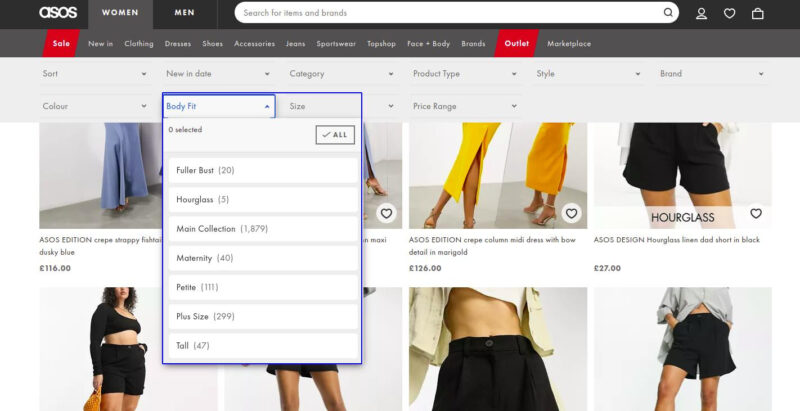
Source: asos.com
In short, including size and height information on your product pages is a win-win for both customers and brands. Not only does it decrease return rates and increase customer confidence, but it also shows that your brand is committed to inclusivity and transparency.
Clear, Detailed, and Truthful Product Information
E-commerce platforms can never entirely emulate the in-store shopping experience, which often leads to customers facing difficulties in comprehending the true essence of their purchases. A study conducted by Invesp discovered that 22% of product returns can be attributed to the purchased item not living up to the consumers' anticipations.
To provide effective product information, it's important to understand your target audience and tailor your descriptions to their interests, values, beliefs, and shopping intent. You should also highlight what sets your product apart from competitors and optimize your descriptions with industry keywords.
But providing too much information can also be overwhelming for customers. It's crucial to curate your information and highlight the product's functionalities, backstory, and unique features that make it special to your audience. Additionally, visual aids such as videos, infographics, or lifestyle photos can enhance the customer's understanding and engagement with the product.
To build trust and transparency with your customers, it's important to be truthful in your product descriptions and avoid over-promising or exaggerating the product's benefits. If the product has any potential drawbacks, it's best to acknowledge them and provide solutions or alternatives.
Provide Technical Information
When it comes to designing a high-converting Product Detail Page (PDP) for your eCommerce website, providing technical information is just as crucial as showcasing high-quality product images and offering clear product descriptions.
The majority of online retailers adhere to the fundamental tenets of price transparency; however, this is not always the case. Research indicates that nearly half (49%) of consumers abandon their shopping carts due to the excessive extra charges they encounter during the checkout process. Additionally, 17% of shoppers exit their carts as they are unable to ascertain these supplementary expenses from the beginning of their shopping experience.
A significant majority, 87%, of consumers regard product content as highly critical or essential when making purchase decisions. The three most frequently examined elements on a product page include product specifications (cited by 76% of users), customer reviews (referenced by 71%), and visual representations (considered by 66% of shoppers).
Nearly all consumers (98%) have been discouraged from buying a product due to insufficient or inaccurate information. Additionally, a considerable percentage (34%) of items are returned as a result of discrepancies in color, fit, or size. By providing more comprehensive, and accurate details (such as shipping and delivery details, return policies, stock availability, and product specifications (e.g., sizing, dimensions, materials)), as well as enhancing the semantic richness of the content, businesses can optimize their Product Detail Pages (PDPs) and improve the overall shopping experience for consumers.
Take inspiration from IKEA, whose PDPs offer a clear overview of product specifications, including details such as assembly instructions, product weight, and environmental information.
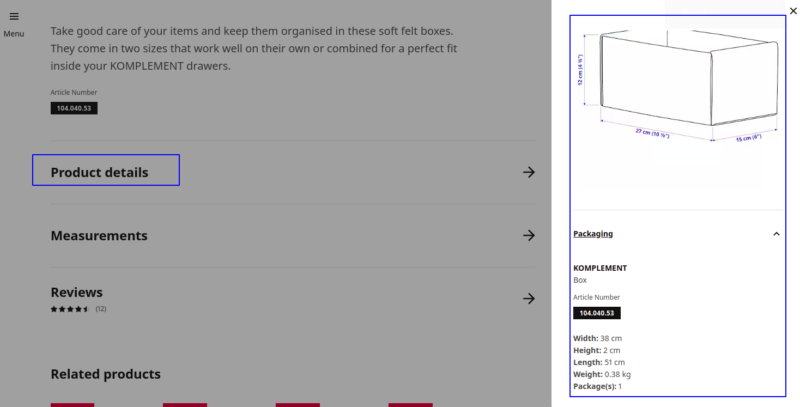
Source: ikea.com
Offer Relevant Product Options
Product options can make or break a customer's experience with your web shop. When customers have options that fit their needs, they are more likely to complete a purchase.
The key to successful product options is to provide relevant options without overwhelming the customer. Too many options can lead to decision paralysis and cause the customer to leave without making a purchase.
One way to provide relevant options is to offer color and size choices for products. This allows customers to find the right fit and style for their preferences. Additionally, providing product recommendations can help customers explore related products and find items that complement their purchase.
Customization options, such as personalized engravings or monograms, can also increase autonomy for customers and make the product feel more unique and valuable to them.
For example, Nike offers product options on their PDP for their shoes, including color choices and customization options. This allows customers to personalize their purchase and find the perfect fit for their needs.
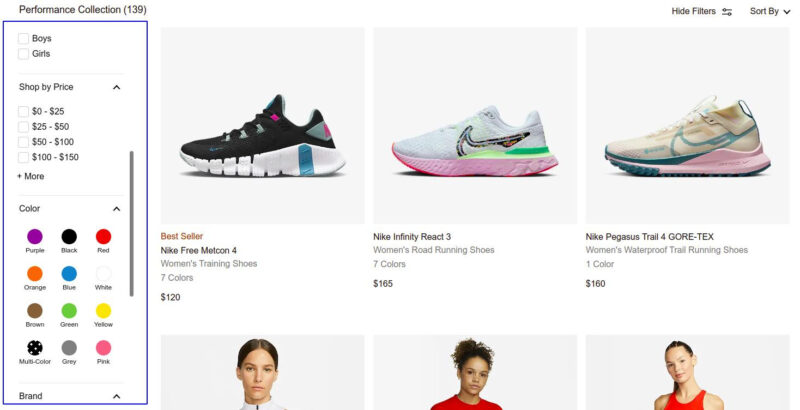
Source: nike.com
It's important to continually test and optimize product options to ensure they are driving conversions and providing a positive customer experience. With the right balance of relevant options, customers will feel empowered to make the best purchase decision for their needs.
Show Your Customer Reviews
In a recent study carried out by Dixa, it was discovered that a staggering 93% of consumers rely on online testimonials and evaluations as a crucial deciding factor prior to making a purchase decision. Furthermore, nearly half of the respondents, accounting for 47%, also emphasized the importance of these reviews.
But customer reviews do more than just create social proof. They also help build trust with potential customers, increase brand loyalty, and improve search engine rankings. In fact, products with reviews receive more search engine traffic than products without reviews.
So how can you effectively showcase customer reviews on your product page? The key is to provide enough reviews to establish social proof while avoiding overwhelming the customer with too many reviews. Research indicates that having just five reviews can potentially increase the likelihood of a product selling by a staggering 270%. Nevertheless, a study also revealed that consumers generally prefer to see a minimum of 40 reviews in order to validate an average star rating. Consequently, although it is not imperative to obtain feedback from every individual customer, securing as many reviews as possible significantly enhances a product's appeal.
But it's not just about the number of reviews - the content of the reviews is also important. Make sure to prompt or incentivize your customers to provide star ratings and written feedback so that potential customers can get a well-rounded understanding of the product. And don't be afraid of negative reviews - responding to them in a professional and helpful manner can actually increase trust with potential customers.
One successful example of customer reviews in action comes from Amazon. Their product pages feature a prominent "customer reviews" section with options to sort reviews by most helpful or most recent. They also include a star rating summary and an aggregate score based on all reviews. This design not only showcases the social proof of customer reviews but also presents the information in a user-friendly way.
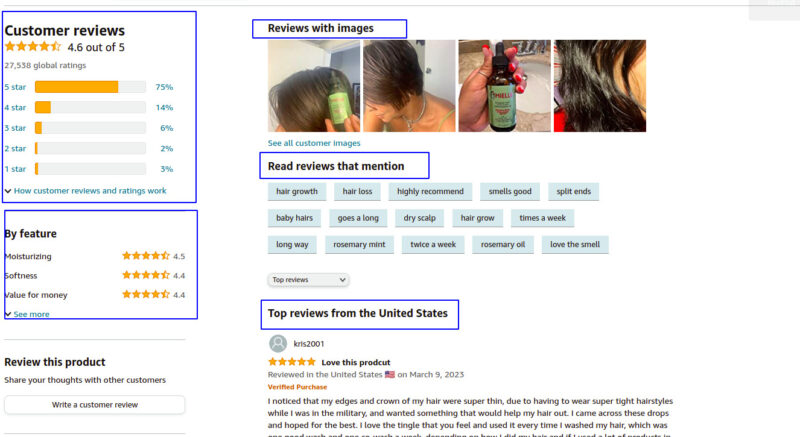
Source: amazon.com
Feature Strong CTAs
Your product pages are your digital storefronts and your customers’ first point of contact with your brand. It’s vital to make sure that your product page design is optimized to draw customers in and facilitate their decision-making process. One key element of this is featuring strong calls-to-action (CTAs).
CTAs are more than just buttons prompting customers to “Buy Now” or “Add to Cart.” They are persuasive messages that help guide your customers towards the desired action. According to a study by Hubspot, personalized CTAs have a 202% higher conversion rate than basic CTAs.
When crafting your CTAs, it’s important to think about your target audience and what language will resonate with them. For luxury buyers, words like “Explore” and “Discover” may be more effective than “Buy Now.” It’s also important to consider the design of your CTAs. They should be eye-catching and prominently displayed, but not so overpowering that they detract from the rest of the product page.
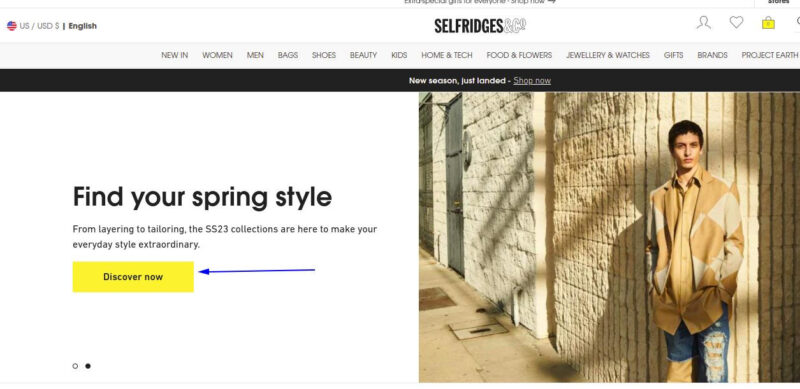
Source: selfridges.com
But don’t stop at just one CTA. Incorporating multiple CTAs throughout the product page can help reinforce the desired action and guide the customer towards the next step. For example, a “Learn More” CTA can help customers gather more information before making a purchase, while a “Share” CTA can encourage them to spread the word about your products on social media.
To ensure that your CTAs are effective, be sure to continuously test and optimize them. A/B testing different variations can help you determine which CTAs are driving the most conversions. It’s also important to make sure that your CTAs are localized to the language and culture of your target audience.
Use Psychology in Your Messages
Designing a visually appealing and user-friendly product detail page (PDP) is only half the battle. To truly capture the attention of your potential customers and drive conversions, you must also understand and leverage the psychology behind consumer behavior. By using messaging that resonates with the human psyche, you can nudge consumers towards making a purchase.
One powerful psychological principle to consider when crafting your messaging is scarcity. Studies have shown that people tend to place a higher value on items that are scarce or in limited supply. By emphasizing that your product is in high demand or only available for a limited time, you can create a sense of urgency and motivate shoppers to act quickly.
Another effective technique is the use of anchoring. This cognitive bias describes how people tend to use initial pieces of information as reference points for subsequent judgments or decisions. By presenting a high initial price, even if it is a fictional one, you can make your actual price seem more reasonable and increase the perceived value of your product.
The endowment effect is another psychological principle that can be leveraged in your messaging. This refers to the human tendency to assign more value to items they feel a sense of ownership or possession over. By using messaging that encourages consumers to imagine owning and using your product, you can tap into this effect and increase the perceived value of your offerings.
But the key to effectively using psychology in your messaging is to ensure that it is grounded in ethical practices and a deep understanding of your audience. By testing and iterating on your messaging, you can find the right balance between persuasion and transparency, and create a messaging strategy that resonates with your target audience.
Refine and improve Product Page Over Time
To achieve eCommerce success, you need to continually optimize your Product Detail Pages (PDPs). Your PDP is the final point of contact with the customer before they make their purchase decision. It is essential to ensure that it provides an engaging, informative, and persuasive experience for the shopper. Continuously optimizing your PDPs can result in a significant increase in conversions and customer retention rates.
In the comprehensive Digital Experience Benchmark report by Contentsquare, it was revealed that the average duration users spend on a webpage across various industries is 54 seconds, highlighting the significance of optimizing page design and performance for a better user experience. Your PDP design can impact the shopper's perception of your brand, product, and the overall shopping experience. A well-designed PDP can increase brand loyalty and drive repeat business.
To illustrate the importance of optimizing your PDPs, let's look at a case study. Nike, the global sportswear brand, implemented a dynamic banner on all their product pages that shows a discount for students. This approach was especially effective during the Back-to-School season as it drew attention to the campaign while providing relevant products. The page also looked freshly updated, which can help boost customer confidence in the brand.
Final Thoughts
You've made it to the end of this journey on mastering PDP optimization in 2024! You now hold the keys to unlock the kingdom of the most exceptional product detail pages that convert and make you a fortune.
With the strategies and tactics we've explored together, you now possess the power to transform your product detail pages into a masterpiece that will leave your customers in awe.
But don't stop here! Keep evolving and optimizing your PDPs to stay ahead of the competition. Keep researching your customers' needs and desires to craft a better user experience. Stay on top of the latest e-commerce trends and use them to your advantage.
Remember, mastering PDP optimization isn't a one-time job. It's an ongoing process of trial and error, research, and optimization. But with every step, you're getting closer to your ultimate goal of being the king or queen of the e-commerce world.
